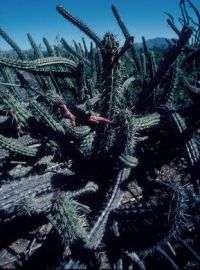One of the host cactus for Drosophila mojavensis. Researchers at the University of Arkansas and the University of Nevada-Las Vegas will study the genetic variation of these tiny flies in their native habitat. William Etges, photo.
Researchers at the University of Arkansas and University of Nevada-Las Vegas will study the genetics of fruit flies in desert habitats to determine how they developed the ability to survive under stressful conditions.
William J. Etges, professor of biological sciences at the University of Arkansas, and Allen Gibbs, professor of biological sciences at the University of Nevada-Las Vegas, have received $950,000 for three years from the National Science Foundation to study the genetic response of the desert fruit fly, Drosophila mojavensis, to environmental stresses in the wild.
Most fruit flies live in mild climates, but a number of species such as D. mojavensis have colonized the desert, using fermenting cactus and surviving in high heat and low water conditions. The researchers plan to identify genes that have helped the fruit flies adapt to these harsh conditions. The genes identified may serve as candidates to predict how well other species can adapt to arid conditions within their lifespan and over generations. This takes on greater importance as arid and semi-arid environments increase globally.
Further, scientists have used fruit flies for genetic model systems in the laboratory for years. Because fruit flies have diversified into thousands of species, reproduce quickly and create many generations in a short time, scientists use them to study evolution, population genetics and diversification. However, laboratory work does have limitations, Etges said.
"No one knows if the processes found in the lab are the same in the real world," he said.
Since the genome of D. mojavensis has been sequenced, Gibbs and Etges will use DNA micro arrays, sometimes called "gene chips," to determine relationships between various genes and environmental conditions in fruit flies found in the wild. A microarray contains thousands of tiny spots on a small slide, each spot representing a different gene in the fruit fly genome.
The researchers will use sensors to monitor temperature and humidity at different desert locations, and they will collect fruit flies from these locations at different times of the year under varying conditions of temperature and water availability. Then they will extract the cellular RNA from the animals, which supplies the code for all the DNA that was currently being expressed by the fruit fly. They transcribe the RNA into single-strand DNA, then wash the microarray with the fruit fly DNA solution. Copies of specific genes in the solution will hybridize with the genes on the microarray, which are modified with a fluorescent dye easily detected by the researchers. The microarray then provides a "map" of what genes are expressed and which ones are not under given circumstances.
"We can look at flies at different life stages and see how genetic activity changes," Etges said.
Determining correlations between environmental stresses and expressed genes does not necessarily indicate a cause and effect, Etges pointed out, but it does give researchers an idea of what genes they should focus on.
Etges has studied the ecology, physiology and genetics of fruit fly populations for more than 20 years. The information gained in this study will add to the body of knowledge about these creatures. Integrating techniques such as microarrays into long-term studies eventually will help researchers determine the genetic process of adaptation and how new species are formed.
"This is the beginning of a long series of investigations," Etges said. Once Gibbs and Etges have determined the genes that respond to stress in D. mojavensis, they can begin to compare the responses to those found in close relatives and look for differences.
"Eventually we want to know about the larger-scale patterns that explain how species are formed," said Etges, a professor in the J. William Fulbright College of Arts and Sciences.
Source: University of Arkansas
























